There are currently millions of pieces of trash orbiting Earth, everything from defunct satellites all the way down to tiny flecks of paint. Each of those millions of pieces of debris is traveling 17,500 miles per hour as it hurtles through space. At those speeds, a collision with an active satellite or spacecraft can cause serious damage. And experts think that if humans don’t do something about all the junk up there pretty soon, low Earth Orbit could become unusable.
This episode we take on a future where space junk has gotten so bad, that active spacecraft are constantly having to maneuver around it, which wastes fuel and cuts down on operation time. And humans decide to finally do something about it. But what?
Guests:
- Loren Grush, science reporter at The Verge
- Lisa Ruth Rand, historian of science technology and the environment.
- Tiago Soares, systems engineer for ESA’s Clean Space program
- Andrew Wolahan, systems engineer for ESA’s e.deorbit program
- Alice Gorman, space archaeologist at Flinders University
- Jill Stuart, space policy & law expert at the London School of Economics
Further Reading:
- Tracking Space Junk
- How can humans clean up our space junk?
- The Space Junk Problem is About to get a Whole Lots Gnarlier
- Orbital Decay: Space Junk and the Environmental History of Earth’s Planetary Borderlands
- The Forgotten Cold War Plan That Put A Ring Of Copper Around The Earth
- Project West Ford, NASA Repository
- Want to get rid of space trash? This gecko-inspired robot may do the trick
- Japanese mission to clear up space junk ends in failure
- This is what happens when a tiny piece of flying space debris hits the ISS
- ESA Envisat
- ESA Clean Space
- ESA e.deorbit
- Space Age Archaeology
- The Death of a Spacecraft
- What is Space Archaeology?
- The Outer Space Treaty has been remarkably successful – but is it fit for the modern age?
Flash Forward is produced by me, Rose Eveleth. The intro music is by Asura and the outtro music is by Hussalonia. The space dispatcher from the top of the episode was played by Andrew Hackard. The episode art is by Matt Lubchansky.
If you want to suggest a future we should take on, send us a note on Twitter, Facebook or by email at info@flashforwardpod.com. We love hearing your ideas! And if you think you’ve spotted one of the little references I’ve hidden in the episode, email us there too. If you’re right, I’ll send you something cool.
And if you want to support the show, there are a few ways you can do that too! Head to www.flashforwardpod.com/support for more about how to give. But if that’s not in the cards for you, you can head to iTunes and leave us a nice review or just tell your friends about us. Those things really do help.
That’s all for this future, come back next time and we’ll travel to a new one.
FULL TRANSCRIPT BELOW
▹▹ ▹▹ ▹▹ ▹▹ ▹▹ ▹▹ ▹▹ ▹▹ ▹▹ ▹▹ ▹▹ ▹▹ ▹▹ ▹▹ ▹▹ ▹▹ ▹▹ ▹▹ ▹▹ ▹▹ ▹▹ ▹▹ ▹▹
Rose: Hello and welcome to Flash Forward! I’m Rose and I’m your host. Flash Forward is a show about the future. Every episode we take on a specific possible… or not so possible future scenario. We always start with a little field trip to the future, to check out what’s going on, and then we teleport back to today to talk to experts about how that world we just heard might really go down. Got it? Great!
This episode we’re starting in the year 2028.
[hissing, beeping]
Radio voice 1: do we have contact with the satellite?
Radio voice 2: not yet
Radio voice 1: when do we start to panic?
Radio voice 2: tomorrow, probably
Radio voice 1: copy
Radio voice 2: satellite contacted, we’re going to have to execute a maneuver
Radio voice 1: why us?
Radio voice 2: the satellite is defunct and uncooperative
Radio voice 1: great
Radio voice 2: instructions incoming
Radio voice 1: nearing path of closest approach
Radio voice 2: t minus 90 seconds
Radio voice 1: reduction wheels still at idle, thruster duty cycle is consistent with expected values.
Radio voice 2: Copy all. Calculate total burn duration.
Radio voice 1: Estimated burn duration is 17 thruster seconds.
Radio voice 2: Radio voice: Latch valves open, line pressure rising.
Radio voice 1: Primary burn complete, verified one second maneuver.
Radio voice 2: Copy, maneuver complete.
[static fades out]
Male voice: good day from the Internationals Space Station flight control room here at the Johnson Space Center in Houston, which in the wee hours of a Saturday morning would usually be devoid of activity on a crew off duty day. But this morning is the scene of cautionary vigilance, as flight director Chris Edelin and his Orbit One team of flight controllers monitor the approach of a small chunk of space debris in the vicinity of the station that prompted the precautionary sheltering of the six crew members in their respective Soyuz spacecraft. Late Friday night, flight director Jerry Jason decided to place the crews in their Soyuz vehicles for a short period of time, after ballistics specialists received data that showed a remote possibility of a conjunction with a small piece a Russian Cosmos satellite.
Radio voice: I don’t see anything, which is a good news
Male voice: Flight controller standing by here in mission control. Just thirty seconds to go until the time of closest approach.
Radio voice: thirty one seconds
[wooshing sound]
[explosion sound]
[fade out]
Rose: Okay, so this episode is a future in which the space around earth has become so full of stuff that satellites are constantly having to maneuver around all of it. And this future is actually not that far off. We might think of space as this vast, emptiness; but the space surrounding Earth is actually full of stuff. And most of it is garbage. Space junk is what people call it.
Loren Grush: Space junk is all the stuff that we put into space and left up there without bringing it back down, intentionally.
My name is Loren Grush and I am a science reporter specializing in space at The Verge dot com.
Rose: The official NASA definition of space junk is “any man-made object in orbit around Earth which no longer serves a useful function.”
Loren: So it runs from things like satellites that we’ve put up there, and that have run out of fuel, and we can’t control them anymore; or the stages of rockets – so those are the upper portions of rockets that push satellites further into orbit in space, and they don’t come back down, so they just kind of stick around up there. And it can also be things that come off of space vehicles over time, so like panels or even flecks of paint. And then there’s some kind of funky stuff too; I believe at one point Gene Roddenberry’s ashes were up there in orbit for a while. And also things that have been dropped during spacewalks from astronauts. So, someone lost their tool bag during a spacewalk one time. So that’s also a space debris.
Rose: There’s also some grosser stuff
Loren: If we wanted to talk about the pee, I love the space pee.
Rose [on the phone]: Oh yeah let’s talk about the pee!
Loren: So, astronauts dispose of all their trash by filling them into these cargo capsules that go to the space station and then they’ll send them down to earth and it’ll burn up in the atmosphere. But, before that happened astronauts used to dump their pee out of the space station and off the shuttle. And so, they would immediately freeze and turn into these beautiful crystals of urine, and those became space debris as well.
Rose: The pee from those earlier space flights has probably burned up by now, but the other junk is still up there. And when I say “up there”, here’s what I mean. Most of what humans put up into the space around Earth, goes into something called “low Earth orbit” which is the region between 160 and 2,000 kilometers above Earth, or 99 to 1,200 miles. The vast majority of space junk is in Low Earth Orbit, so that’s mostly the region we’re going to talk about when we talk about space junk, because that’s where most of the problems will arise. To try and predict and avoid those problems, scientists have to track the space junk that’s out there. But they can’t track all of it. The tiny stuff, like the flecks of paint, are too small for even really advanced sensors to keep track of.
Loren Grush: The ground based telescopes that we use to track debris can only track things down to about 10 centimeters in size. And the analogy is about the size of a softball or baseball. So, theoretically we think there’s millions up there, but I believe that we we only are tracking about 22,000 pieces of debris right now.
Rose: And countries have to track this stuff, because if one of their satellites or space stations collides with a piece of space junk, it can be totally catastrophic.
Loren: Things in lower earth orbit are typically going about 17,000 miles per hour. So, even if you do have something tiny floating around up there, it’s not really floating it’s speeding around Earth at super high speed. So, if that hits you, even the smallest piece of debris can cause a big impact.
Rose: Right now, every new launch into space has to take into account whatever might still be in orbit around the planet, whether that’s an active satellite, or a piece of debris from a defunct mission. Launch trajectories have to be calculated to avoid collisions with orbital debris. But satellites that are currently in orbit also have to be careful.
In 2009, for example, a collision between two satellites created thousands of new pieces of space junk.
Loren: The Cosmos satellite was owned by the Russian Space Forces and the Iridium satellite is owned by a communications company called Iridium. And Iridium was still active. It still had propulsion, but the Cosmos satellite did not. And so once you run out of fuel, you obviously can’t control how it works anymore in space. And then they ended up colliding and it put thousands of pieces of debris into Low Earth Orbit.
Rose: In 2012, the Fermi mission had to use the spacecraft’s thrusters to avoid colliding with an old Soviet spy satellite called Cosmos 1805.
And things are about to get a whole lot more crowded up there. With the boom in private space companies like SpaceX, there are a lot more things going into space these days than there used to be. Thousands of new satellites and CubeSats and other devices are set to launch in the next ten years.
And experts warn that if we don’t do something about space junk soon, we might wind up in a situation where the space surrounding Earth becomes too hazardous to traverse.
Loren: The big thing that everybody points to is this thing called the Kessler syndrome. And it’s this idea that if you put too much junk into space and they collide; well they can create more pieces of debris. Then those pieces of debris are going super fast, and they can run into other things and cause this avalanche effect where you just have so many things in Low Earth Orbit that it becomes pretty inhospitable to future spacecraft so that we wouldn’t be able to put things up there anymore.
Rose: If you’ve seen the movie Gravity, you are familiar with this concept, right? In the movie, Sandra Bullock and George Clooney are trying to stay alive after a chain reaction of collisions send debris hurtling their way, and destroy their shuttle and telescope.
Loren: We’re definitely not at that level yet, but that’s kind of the concern of why we need to mitigate this problem now.
Rose: So, it might seem like this space junk problem is a new one right. The common story goes like this: when humans started sending stuff up into space in the 1950’s, starting with Sputnik, they didn’t really think about cluttering up space. They weren’t thinking about or talking about space junk, because there was nothing in space to begin with. But now, all these years later, we’re starting to realize that we’ve created a problem.
The thing is, this story, that we only started thinking about and caring about space junk recently, isn’t true.
Lisa Ruth Rand: Even at the very start of my research, I came to see that that was far too simplistic a picture. That, in fact, we’d been thinking about space junk since the very beginning of the space age.
My name is Lisa Ruth Rand. I am a historian of science, technology, and the environment. And I am currently writing a book about the history of space junk and how space just became became seen as an environmental problem during the Cold War.
Rose: Take, for example, Project West Ford.
Ruth: It was originally called Project Needles, and it was designed to be a communications satellite communications system that would be resilient in the case of a certain kind of nuclear war.
It was first tested in 1961. It did not succeed, and then it was successfully tested in 1963.
Rose: Essentially, Americans were worried that in the case of a nuclear war, all the fallout might make radio communications on the ground unstable. So they wanted to install a communication system that they could rely on in space. And the solution they came up with, was very strange but also kind of genius.
Ruth: West Ford consisted of 400 million copper fibers that were thinner than a human hair, only a few centimeters long each. And they were placed into a 3,500 kilometer orbit, in a band around the planet.
Rose: These copper fibers, which many people called needles, were dipole antennas. The idea was that if you put up a bunch of these tiny antennas in a band around Earth, you could bounce radio waves off of them and use them to communicate.
The nice thing about this system, was that because it was a whole bunch of individual pieces, it’s really hard to destroy.
Ruth: If you have a field of hundreds of millions of copper fibers, you’re not going to take out that whole thing with one nuke necessarily. A) you could put up a new one really quickly or B) that field would congeal and fill gaps.
Rose: Plus, the copper dipoles, the needles, were cheap and easy to produce, and it was relatively easy to launch up into space.
Ruth: In many ways this was a really interesting project, and one that I argue was a pretty elegant solution to a geopolitical reality at the time.
Rose: But as soon as the project was publicly announced, people started asking questions about what the impact of putting all these pieces of copper up in space might be.
The first detractors were the astronomers.
Ruth: Their main concern was what would happen if if such a test was successful, and this dipole communications method became the norm. what would happen if they sent up, let’s say the Air Force decided they just send up a fully functional system which would require a much denser belt of needles around the equator and the poles. So then what would happen if the Soviet Union decided they wanted one, too. What if Europe wanted one. Suddenly we’d have a sky filled with copper dipoles.
Rose: And astronomers went in hard against Project West Ford, they were not messing around with their complaints.
Ruth: I have a letter from one astronomer saying that if astronomers didn’t take firm action against West Ford it would be akin to Chamberlain’s appeasement of Hitler in the lead up to World War II. I mean, they really took this seriously.
Rose: Astronomers protested Project West Ford so vocally that they actually wound up taking it to the floor of the United Nations.
Ruth: The U.S. State Department had to get involved in negotiating between the astronomers and the Department of Defense. And the international community of scientists really raised the alarm about what could happen if states were allowed to just launch willy nilly without consulting with the scientific community first to make sure that it would not cause any sort of environmental harm.
Rose: But it wasn’t just scientists who didn’t like the idea of throwing up all of these needles. The public got really invested in this too. And this was in part because right around the same time that Project West Ford was being tested, something else was happening in the United States.
Ruth: So, the first one launched in 1961, the second in 1963, and then the middle in 1962 was the publication of Silent Spring by Rachel Carson. Which seen, and continues to be seen as really a major turning point in what came to be mainstream environmentalism.
Rose: One of the big themes of Rachel Carson’s book, Silent Spring, is the idea of invisible pollution. She’s mostly talking about pollution from chemicals and nuclear waste, but you could see space junk as another form of invisible pollution, right? You can’t see it.
Ruth also points out in her work that a year after Project West Ford’s second launch, the United States passed the Wilderness Act of 1964. And she notes that space can kind of actually fit the description of wilderness defined by the bill which was, “where man himself is a visitor who does not remain”. That describes space pretty well, right? So Project West Ford, became emblematic of space junk in the 1960’s.
Ruth: This became a very big story in mainstream presses around the world. A lot of editorials pushing back against what they refer to as the cluttering and littering in space.
Rose: Newspapers all over the United States and abroad wrote about this project polluting Near Earth Orbit. There was a story in a Soviet newspaper with the headline “U.S.A. Dirties Space.” And this conversation about space junk, and the idea that we could be polluting our orbits, never went away. Space junk was such a topic of conversation that the band Devo actually wrote a song about it in 1978.
DEVO: she never saw it
When she was hit by space junk
When she was hit by space junk
When she was hit by space junk
In New York, Miami beach… [fade out]
Rose: Today, there are actually still some of the Project West Ford needles up in space. They were supposed to come down naturally, but some of them clumped together and remain stubbornly orbiting our planet.
Ruth: Anyone who’s a geek like I am, and likes to go online and try some of the space tracking software that’s freely available; if you put it in West Ford you can see that there are clumps that are catalogued, and you can see where they are in real time. Still a couple thousand kilometers above our heads.
Rose: Okay, so fast forward to today, or FLASH FORWARD, if you will. I don’t think I’ve ever used that joke on the show, and I think I’ve now used up my one Flash Forward joke quota. But today, we are still having this conversation about space junk, and how to responsibly manage all the stuff up there. Most people agree that if we want to continue to launch satellites and other stuff up into orbit, we’re going to have to do something about all the junk up there. The question isn’t whether we should do something, but instead what exactly we should do.
Loren: There’s so many different ones and they’re all so very creative.
Rose: That’s Loren Grush again.
Loren: People have talked about using a harpoon to literally spike the satellites, and then use some kind of sail to drag them down. Space lasers have been proposed as a way of heating up the spacecraft and shifting its orbit. There are a lot of different methods that have been proposed and no one can really quite agree on the best one just yet.
Rose: And when we come back we’re going to talk about all the ways that space agencies have proposed pulling some of this junk down, and we’re also going to hear from an archaeologist about why maybe… we should leave some of it up there. Plus, if two satellites collide, who’s responsible? All that and more, after this quick break.
[ADS]
Rose :Okay, so space junk has been an issue for a long time. But now, we are going to try and do something about it. Now, even if we didn’t do anything about space junk the planet would help us out a little bit.
Ruth: Three cheers for the atmosphere. The atmosphere does so much for us, both in terms in terms of cleaning up our messes within the atmosphere – you know on the ground – but also it cleans up our messes in outer space.
Basically, our atmosphere expands and contracts along the eleven year solar cycle. So, the sun sends out more or less energy along that relatively predictable cycle. At moments of high energy it’s called solar maximum, and at lower points, where it’s setting out less energy that’s called solar minimum. And at solar maximum the sun sends out a lot of extra energy. The Earth’s atmosphere heats up and expands into space. So, more objects are subject to that friction, to the atmosphere particles that friction, and re-enter the atmosphere.
Rose: Basically, every eleven years the atmosphere of the Earth gets a little bit hotter, which puffs up the atmosphere up a little bit, and that puffed up atmosphere provides extra drag on the debris in Low Earth Orbit. That drag pulls down some of those objects, most of which burn up in the atmosphere as they’re dragged down.
Ruth: It’s very much a systemic kind of exchange. And it’s one that we don’t have any control over, but we’re very, very lucky it takes place. Because if it didn’t, Low Earth Orbit would be far more crowded than it is today
Rose: I like to think of this as the Earth’s menstrual cycle.
Ruth: Haha, the eleven year menstrual cycle, yes. Hoo, can you imagine that every eleven years?
Rose: But that solar cycle can’t do everything for us, and most experts think that we should start actively removing things from space. But how? For all of the things we’ve launched up into orbit around Earth, we’ve actually never gone out into space and pulled anything down.
Andrew Wolahan: A capture of an uncooperative object in space hasn’t been done before.
Rose: This is Andrew Wolahan, a systems engineer at the European Space Agency. Andrew works on a project called e.Deorbit, which has been trying to figure out the best way to take down a defunct satellite. Or, in technical speak, an uncooperative object. And these uncooperative objects… they aren’t going to go quietly.
After years of hurtling through space, these objects might have started to slowly fall apart, or they might have been hit by space debris already, and broken. And any of those things can make these uncooperative objects start to spin.
Andrew: And this can range from 0.1, 0.2 degrees per second; to I think we’ve even observed satellites spinning at 20 degrees per second.
Rose: So, here’s the challenge: you have an object hurtling through space at 17,000 miles per hour. It’s also spinning, and you don’t necessarily know how fast it’s spinning, or even whether it’s still going to be spinning at the same speed by the time you get there. And you have to go up, and try to grab this object, and bring it down to Earth, without running into any of the other things that are also orbiting Earth. No problem right!?
There are all kinds of proposed solutions here, and Andrew and his team looked at a lot of them.
Andrew: We started with the idea, of course, a robotic arm. Then we looked at some more exotic ideas, like using a fishing net or some sort of net type thing that has been around, of course, for thousands of years and has been re-engineered by humans many times. We also looked at using a harpoon to shoot and grab the target. And then we studied some other concepts, like using glue, or hooks, or straps, or something else. Or a type of spider web concept, where we’d fly around the satellite to put some sort of silk, and then wrap it up slowly.
Rose: You might remember that Loren mentioned the harpoon idea too. But Andrew and his team at ESA actually rejected the harpoon idea pretty quickly.
Andrew: One of the biggest issues with the harpoon concept is that the satellite that we want to capture, the satellite will have been in orbit for fifteen or twenty years, and the material on the surface of the spacecraft will have been going in and out of sunlight; will have been thermally heated up, then cooled to very extreme temperatures.
Rose: These conditions can be really, really hard on even the strongest materials. But there’s not good way for scientists like Andrew to simulate how these conditions specifically impact each material. They can’t even accurately model what each material might be like, at this point. Which means that when they shoot the debris with the harpoon, they’re not exactly sure what might happen.
Andrew: So there’s a risk that if we shoot a satellite with a harpoon, that we don’t know really what the surface structure of the spacecraft, what’s going to happen to this. So we could get some sort of fragmentation of the structure, and then the harpoon may not be effective at all.
Rose: So now, Andrew’s team at ESA are really focused on two different possible debris removal techniques: a net, and an arm. And both of them present their own, unique challenges.
Let’s start with the net. The pro for the net is that you don’t have to get as close to the thing you’re trying to grab.
Andrew: With the net, we can sit about fifty meters, or 100 meters away from the target that we want to capture. We can then shoot it from fifty meters, 100 meters, away. There’s no risk of collision during the actual capture.
Rose: But the challenge with the net, is that once you shoot out the net, and grab the target, you now have a spinning object in a net that’s tied to your spacecraft.
Andrew: The minute it successfully wraps around the target, we start to get this winding effect. So with the net, it’s very easy to capture the satellite, but once you’ve captured the satellite, it’s very difficult to stabilise the two systems. And then the other thing is, once you’ve stabilized it, you need to move it from point A to Point B.
Rose: The other proposed method that they’re looking at is the robotic arm. This requires your recon spacecraft to get really, really close to the object that it wants to capture.
Andrew: Here, once you’ve captured the target, it’s quite simply. Because there’s no risk of collision. But the biggest challenge is actually performing the capture, because the target, again, is spinning. So we need to approach it. If we imagine we have a four meter long, or five meter long robotic arm, we need to get maybe two meters, surface to surface. Like, two metres distance from the target spacecraft. Andm as we’re approaching it. because it’s spinning. we need to actually start performing what we call synchronized motion. So, it’s almost like a synchronized dance, where we’re tracking the target, and specifically a capture point that we’ve identified.
Rose: This capture point, that Andrew mentioned, is actually a big piece of this problem. You need to grab onto this piece of junk… but where’s the best place to grab?
e.Deorbit, the project Andrew works on, is specifically using a spacecraft called Envisat as their case study. Envisat was launched in 2002 and it’s an eight ton satellite that carried with it 10 different instruments for observing the Earth. But in 2012, ESA unexpectedly lost contact with the satellite. And they were never able to get it back. So now, this eight ton behemoth is orbiting Earth, doing… nothing basically. And it’s in a really precarious orbit too, it’s where a lot of other spacecraft would like to be.
Because Envisat is an ESA spacecraft, they have a ton of information about how it works, and what it looks like, including detailed 3D models of the satellite itself. So for this robotic arm approach, they know exactly where they want to grab the satellite.
Andrew: For e.Deorbit, we want to grab the Envisat adaptor ring. So, this is the ring that’s designed on the spacecraft to transfer the launch loads. So generally, it’s quite robust and we have a lot of information on the materials, etc.
Rose: So they grab onto the launch adaptor ring, and then they have to use thrust to slow down the captured satellite, and bring it down to Earth.
Andrew: And this is a very complex option, in terms of the robotics, robotic controller, and also the controller that’s moving the spacecraft in the synchronized motion; as to who is driving this system
Rose: As if this all doesn’t sound complicated enough, there’s more! During this whole maneuver, they might actually not even be able to communicate with the ground.
Andrew: All of this is done in orbit. The actual capture process, that day itself, takes about 30 minutes. And when we’re in this synchronized motion flying, around Envisat, we can’t guarantee that, on ground, we’re going to be able to actually communicate, or talk, to provide commands to the chaser; the chaser that’s performing the capture.
Rose: So yeah, this is… really complicated! And really hard. But Andrew thinks its doable in the near future.
Andrew: If the money wasn’t a question, and somebody gave us the money to do it today, we’d probably be able to launch a satellite within six years capable of capturing Envisat, or another spacecraft.
Rose: But even if he’s right… that actually won’t be enough.
Tiago Suares: We can develop technology that can remove debris in the future, the most risky ones. But if we keep polluting, there’s no point in doing that. Because it would be: every mission we remove, we’ll have tens of others that would stay in orbit. Removing one satellite will not make a difference.
Rose: This is Tiago Suares. He also works at ESA, but he focuses mostly on the other side of the space debris question, which is figuring out how to reduce the amount of junk that we leave up there in the first place. And a lot of that work has to do with how scientists design their spacecraft. For example, Andrew’s project is using the Envisat as a test case. And with Envisat they know a lot about the satellite, what to look for, what it looks for, and where they could grab onto. But that’s not the case with a lot of the junk up there.
Tiago: They don’t have, let’s say, visual marks that allow us to to rendezvous with them, so we have to go with a lot of uncertainty. We don’t know if the parts of the satellite have broken or not. So, to do the navigation around it; to know exactly where your satellite is with respect to the other is extremely hard. They also don’t have any capture point. So we have to go to try to figure out, out of their configuration, a capture point.
Rose: Future spacecraft should have visual markers on them, to help removal craft orient themselves. They should also have designated grabbing points.
Tiago and his team also propose that satellites actually stick to their designated lifespans, instead of trying to squeeze every last minute out of their operating time. Often, even if a satellite has a plan for it’s end of life, the people operating it will try to push that date back as far as possible… often until it’s too late.
Tiago: Once you launch a satellite, what comes after is what you build it for, of course, since its function is also what you sell. Even if the satellites had been designed to de-orbit at the end of life, in the majority of the cases they would not de-orbit at the end of life, because people would extend the operations indefinitely.
Rose: Tiago also says that satellites should also be designed to burn up in the atmosphere as they come down to Earth, so that nothing falls in the wrong place and hurts someone. That means designing a spacecraft to break up in certain ways, and reenter the atmosphere in a specific sequence that maximizes the incineration potential.
Tiago: For certain equipment that are more critical, like tanks, that would survive the reentry and hit the ground, we try to design them in different material that will melt during the reentry. Or we try to have weak links that will break the structure of certain mechanisms or certain equipment that we see more critical to make sure that they will melt during the reentry.
Rose: Right now there are a handful of technologies that can help with this kind of reentry, like something called a Terminator Sail, which is a very cool name. And there are some spacecraft in space now who have these kinds of end-of-life technologies. But we won’t know if they work for a while.
Tiago: You know, one of the difficulties we have with these technologies is that if you put them on board, we will only know if they will work fifteen years later. You have to wait for the satellite to be decommissioned to know if it worked.
Rose: And if a satellite doesn’t burn up on reentry, that’s when space junk turns into terrestrial junk. And that is a whole other problem that we don’t actually quite have time to delve into on this episode. But Patrons are going to get more about that side of things in the special Patreon newsletter this week. So, if you sign up as a $2 patron, you can learn more about how a Russian nuclear reactor fell out of the sky and into a remote region of Canada, and how the environmental pollution from that incident impacted the First Nations people who lived there…
Ruth: So suddenly you have this what looks like an invasion force coming into your small town, and people who look like a yellow Darth Vader coming in and saying you can’t leave your house, you have to stay home. You can’t go to your nets, you can’t go to your traps. Something has happened, and what do you do if you only speak Inuktitut, and you don’t understand what’s going on.
Rose: More on that in the Patreon newsletter.
Okay, back to Tiago. All of these new design choices to make satellites and spacecraft more eco friendly, they take time and money to research and implement.
Tiago: In ESA we also have a mandatory implementation of all these rules to all the satellites we launch. And we had a case where a satellite was already in critical design review, in the last review. And they had to change very, very significantly the design, because they were not compliant with the maximum casualty on ground.
Rose: It’s really a whole new way of thinking about satellites.
Tiago: And this is a really new field, because in the past, we have always been designing satellites to survive. And now we’re trying to design satellite so that in certain conditions they completely disappear. They vaporize.
Rose: But not everybody thinks we should vaporize all of our past satellites and spacecraft.
Alice Gorman: I would be sad, because I do want to see this stuff. The issue of authenticity is at the heart of this. For archaeologists, touching some ancient artifact that no person has touched for 6,000 years is an incredibly potent thing. Being in the presence of a historic, ancient satellite like Vanguard 1 or like Telstar 1; being in the presence of the real thing, not just a model in a museum or a mock up somewhere, that’s such an incredibly powerful thing.
I’m Alice Gorman. I’m a senior lecturer at Flinders University in Adelaide in South Australia. I’m an archaeologist and the focus of my research is stuff in space
Rose: Yes, that’s right, a space archaeologist! I had no clue this was even a thing until I found Alice’s work. And it’s kind of counterintuitive right?
Alice: Normally people don’t think of contemporary rubbish as archaeological artifacts, so we ignore that and we look for the the 18th century ceramics, or the 6,000 year old stone tool. But if you look at contemporary rubbish as a source of archaeological information, suddenly you see all these other things.
Rose: What Alice does is study objects that not only were created in the very near past, but also objects that are out in space, that she can’t actually hold or touch. Now, you might be wondering, as I did when I first encountered this work… wait a minute. Archaeology is a field where researchers find really old stuff, and they try to figure out what that really old stuff is, and what it can tell us about a culture or people that we don’t know very much about. But, in this case, we know a lot about these objects, right? We know what they were used for, we know who made them; plenty of those people are still alive even.
But Alice argues that applying an archaeological lense to this stuff can often unearth hidden layers, things that we think we know, but we don’t actually know.
Alice: People say they’re doing things for these reasons, but often they’re not aware of the deeper reasons why they’re doing something.
I think, actually the best way to illustrate this sort of thing is people may have seen a film called The Devil Wears Prada. And there’s a famous scene in that, where Miranda Priestly, played by Meryl Streep, is explaining to the young Andy, her assistant, why what she thinks is her choice of a blue jumper to wear that day is just a meaningless choice. And Miranda explains how the colors for that season were in fact determined some years before by some of the world’s leading designers.
Miranda Priestly: Oh, ok. I see, you think this has nothing to do with you. You go to your closet and you select out, oh I don’t know, that lumpy blue sweater, for instance, because you’re trying to tell the world that you take yourself too seriously to care about what you put on your back. But what you don’t know is that that sweater is not just blue, it’s not turquoise, it’s not lapis, it’s actually cerulean. You’re also blindly unaware of the fact that in 2002, Oscar de la Renta did a collection of cerulean gowns. And then I think it was Yves St Laurent, wasn’t it, who showed cerulean military jackets? (I think we need a jacket here…) And then cerulean quickly showed up in the collections of eight different designers. Then it filtered down through the department stores and then trickled on down into some tragic “casual corner” where you, no doubt, fished it out of some clearance bin. However, that blue represents millions of dollars and countless jobs and so it’s sort of comical how you think that you’ve made a choice that exempts you from the fashion industry when, in fact, you’re wearing the sweater that was selected for you by the people in this room. From a pile of “stuff.”
Alice: Actually, it’s a beautiful piece, and it illustrates what archaeology does. It looks at the reasons why people make decisions, and what is the bigger picture behind them that that person may not even be aware of.
Rose: So, take for example different tracking stations built during the 1960’s. NASA built one in Canberra, in Australia. And Alice has done a lot of work on that site, looking at it from an archaeological perspective.
Alice: But I also started to look at some French tracking stations. And what I found really, really interesting there was that they had a completely different style. So, in some ways the functions of the infrastructure were identical. You had some kind of antenna that was pulling down the signals from space, putting them through signal processing, and modulating, and all of that into the computer where they get turned into data. So all of that is the same thing that’s happening. But when you look at the physical construction of both of these sites, they’re incredibly different. And you could say one has an American style and one has a French style. Sot these are the sort of cultural choices of the kind that are evident at the archaeological scale.
Rose: This kind of analysis can be made of space junk, too. It’s the classic cliche: one person’s trash is another person’s treasure. And for Alice, defunct satellites, pieces of space debris, even paint chips; they all have an archaeological value. They’re not pieces of junk, they’re more than that!
Alice: Junk is, it’s a bit too simple, and it was fine for a while. Junk is a great term to get people aware of what some of the environmental issues are around having some space junk up there. But it’s maybe a good time to kind of think about the complexities of that a little bit more.
Rose: So, Alice would actually love to see some of the space junk stayin space. So that it can be studied. She sees it as cultural heritage, the same as a historic building, or an archaeological site. Of course, Alice also recognizes that some space junk can be dangerous, and she’s not advocating that we keep stuff up there that are going to cause damage.
Alice: It is a very serious problem, and we do need to get rid of some of that stuff. So if something looks like it is going to become a high collision risk, okay we have to do something about that. And that may involve taking it out of orbit. But until we have to do that we shouldn’t preemptively do it.
What I want to do is work out what is culturally significant and leave it up there.
Rose: Archaeologists determine the cultural value of something using a five point system.
Alice: Which are: historic, aesthetic, social, spiritual, and scientific. I guess we kind of try to predict in the present waht future generations are going to be grateful for. What they’re going to say, “oh, I’m glad you thought to try and preserve this because now it’s really important to us.” So, you’re not always going to be able to predict that accurately, but we have to give it a go.
Rose: And Alice thinks that future generations will thank her for not just blowing everything up.
Alice: If we think forward 500 years into the future, will there be anything left of this early space age? Will people look back at Earth orbit, and see some recent satellites and wonder where all the early ones are and what they looked like? Just five hundred years from now, you can bet all of those records that exist currently won’t be around. The digital stuff will be unreadable. A lot of it will have been corrupted. Maybe, all there will be 500 years from now are the actual bits of stuff in Earth orbit themselves. So part of this I think is just about trying to make responsible decisions for the future, in the best way that we can.
Rose: So if Alice gets her way, there will still be stuff up in space. Our trash stays there, so that people can study it and learn from it. But what happens if that trash actually does collide with something? Who’s responsible for that collision?
Tiago: It is difficult to prove who is wrong, because imagine two satellites collide like happened between Cosmos and Iridium, the Russian and American satellites in the past. Who is to blame? I mean, one was non-operational, and the other decided not to move. So, one can say, “I was not operational. What do you want me to do?” The other can say, “we’ve decided not to move.” And then this generated thousands and thousands of debris that are, let’s say, annoying everybody else, and the operations of everybody else. But who is to blame in all of this, it’s difficult in space.
Jill Stuart: In all of international law, there’s not an obvious enforcement mechanism, in a lot of cases. And particularly when it comes to outer space there isn’t.
Rose: This is Jill Stuart.
Jill: And I’m an academic based at the London School of Economics. I’m an expert in the politics, ethics, and law of outer space exploration and exploitation.
Rose: So, there are a handful of treaties that govern outer space. The most applicable, when it comes to space junk are the Outer Space Treaty of 1967, the Liability Convention of 1972 and the Registration Convention of 1974.
Jill: And what these three treaties do is they say that outer space is neutral territory, and that any object launched into outer space is the responsibility of the launching country. And that any object that does damage in outer space, or on Earth from outer space is the responsibility of the launching country.
Rose: But there’s no real enforcement mechanism for these rules. So… why does anyone follow them? Jill says that basically … because they don’t want to look bad.
Jill: The best reason that I can come up with is that I think that, particularly when it comes to outer space, which a lot of country’s citizenry have sort of romantic ideas about, and they don’t want to see their governments as violating these treaties. So they have a strong sense of wanting to be seen as legitimate in the ways that they’re acting in out space.
Rose: So far, there hasn’t been a case where a collision has required adjudication. In the case of Iridium and Cosmos, nobody decided to protest the collision. In another case, the collision wound up being a little bit of an own goal.
Jill: In 1996, it was interesting. You may have come across this case of the French satellite that was damaged by a piece of debris, and the French were very angry about this until they realized that the debris was from another French satellite, or a rocket booster, I believe it was. But that was meant to be one of the first test cases. But it wasn’t carried out, ultimately.
Rose: But at some point, there probably will be a situation in which two things collide and we have to figure out who is responsible. And when that happens, there will be a few key things at play. First, today’s modern spacecraft are all insured.
Jill: Because space objects are so incredibly expensive, there was just a really basic financial concern. So, if two objects were to collide in space, there was going to be a massive bill and we needed to think about who was going to pay for that.
Rose: So you’ll have insurance companies involved in what happens next. So it might wind up being a bit like one of those chain reaction fender benders, where one car in the back crashes into a string of cars, who bump each other down the line. Usually, when that happens, the first car, the one that hit everybody, has to pay the damage for every car in that chain reaction.
But with space junk, once you’ve tracked down what piece of debris started the collision, you might still wind up in a bit of a tangle. It used to be that things launched into space came from a single country, and usually their national space program. But now… things are a lot more complicated.
Jill: You have multi-national corporations, so you might get an object that’s been launched into space on a rocket that was produced in one country. It might be a satellite that’s privately owned, it may have been launched from the high seas on a ship that was produced in a completely different country.
Rose: Nobody predicted this when they made the rules in the 1960’s and 1970’s. Jill has argued that the current laws surrounding space should be updated to reflect this more complicated reality. Because if they aren’t, it’s possible space could wind up just as messed up as Earth’s.
Tiago: I think it’s like climate change, in a sense. Because it requires, very often, international agreement. It is very easy to hide behind the fact that some countries are not to blame, to say if the others don’t apply then they have competitive advantage and we’re losing etc.. So you see these arguments all the time.
Rose: Jill is actually more optimistic.
Jill: The outer space environment absolutely has a potential to be a tragedy of the commons type environment. But, what my researchers found is that actually entities and individuals that are involved in outer space activity are fully capable of coordinating their activity. Partly because of the fact that they’re aware that if everyone is contributing to the destruction of the environment there, then no one will be able to use it.
Rose: But what about this… What if I was an eccentric billionaire who decided that after all of my years of polluting the outer space environment, I wanted to put my money into building a giant space Roomba that could just suck up all the space junk out there and incinerate it, or something. Well, in this situation, I’d probably get into trouble pretty quickly. Because it turns out you can’t just go up there and start pulling things down willy nilly.
Tiago: And of course, there are some restrictions on satellites, especially that use restricted hardware that cannot be touched, or known, or seen by other other countries. And these are not even only speaking about defense satellites, even in commercial ones.
Rose [on the phone]: And I can’t just go around scooping up people’s satellites, if I wanted to?
Tiago & Andrew: Laughter
Jill: So, if there can be a situation where you develop, as you say, a space Roomba that could go up to hoover up some of this debris, that we could figure out a way to unpack the legal situation so that you wouldn’t be overly disincentivized to do that. But at the same time, the rules are there for good reason. You also don’t want it to be a free for all.
Rose: You don’t want it to be a free for all, for sure. But you also don’t want it to be so hard to do that nobody even tries to clean this stuff up, right?
Jill: Considering that it is junk, and that ultimately we want to incentivize companies to go up there and take it down. Let’s say you go up there, and try to take something down, and then accidently knock it off orbit, and then it goes and causes an accident. It’s almost like we need a Good Samaritan law for first space. If you’re trying to take something out of orbit, and it causes an accident, then there’s some sort of mitigation. And again we don’t have any test cases on this. So I think it’s not entirely clear.
Rose: One way that cleaning up all of this space junk might be incentivized is if people figure out how to actually use it and turn it into a valuable resource. THere are a variety of proposals for how to gather up space junk, condense it down, separate out the components, and actually sell those back to companies. That’s still really early work, but if that works, then there’s money to be made in my space Roomba idea.
But, for now, my hair brained scheme of a space Roomba is probably not actually a very good idea. Plus, I’m sure that Alice, our space archaeologist, would have some choice words for me if I just stared hoovering up all the stuff out there. But this is a future that you’re about to see come to fruition, pretty soon there will be test missions to try and remove space junk. And what happens next is going to get weird, and probably pretty interesting! And if you do want to start a space roomba company, call me, I’m in.
[music up]
That’s all for this episode. Flash Forward is produced by me, Rose Eveleth. The intro music is by Asura and the outro music is by Hussalonia. The space dispatcher at the top of the episode is played by Andrew Hackard The episode art is by Matt Lubchansky.
If you want to suggest a future that we should take on, send us a note on Twitter, Facebook or by email at info@flashforwardpod.com. We love hearing your ideas! They’re so fun. And if you think you’ve spotted one of the little references I’ve hidden in the episode, email us there too. If you’re right, I’ll send you something cool.
And if you want to support the show, there are a few ways you can do that too! Head to www.flashforwardpod.com/support for more about how to give. But if that’s not in the cards for you, you can head to Apple Podcasts and leave us a nice review or just tell your friends about us. Those things really do help.
That’s all for this future. Come back next time, and we’ll travel to a new one.
[music out]
[static fades up]
Radio voice 1: Please divert your course 300 meters to avoid a collision.
Radio voice 2: Recommend you divert YOUR course 300 meters to avoid a collision.
Radio voice 1: This is the science director for the TK station. I say again, divert YOUR course.
Radio voice 2: No. I say again, you divert YOUR course.
Radio voice 1: This is the space station Starthinker, the second largest ship in the United States’ Space Fleet. We are accompanied by fourteen cubesats, seven probes, two magnetic sails and numerous support vessels. I demand that YOU change your course 300 meters, that’s three zero zero meters, or countermeasures will be undertaken to ensure the safety of this ship.
Radio voice 2: This is the moon. Your call.
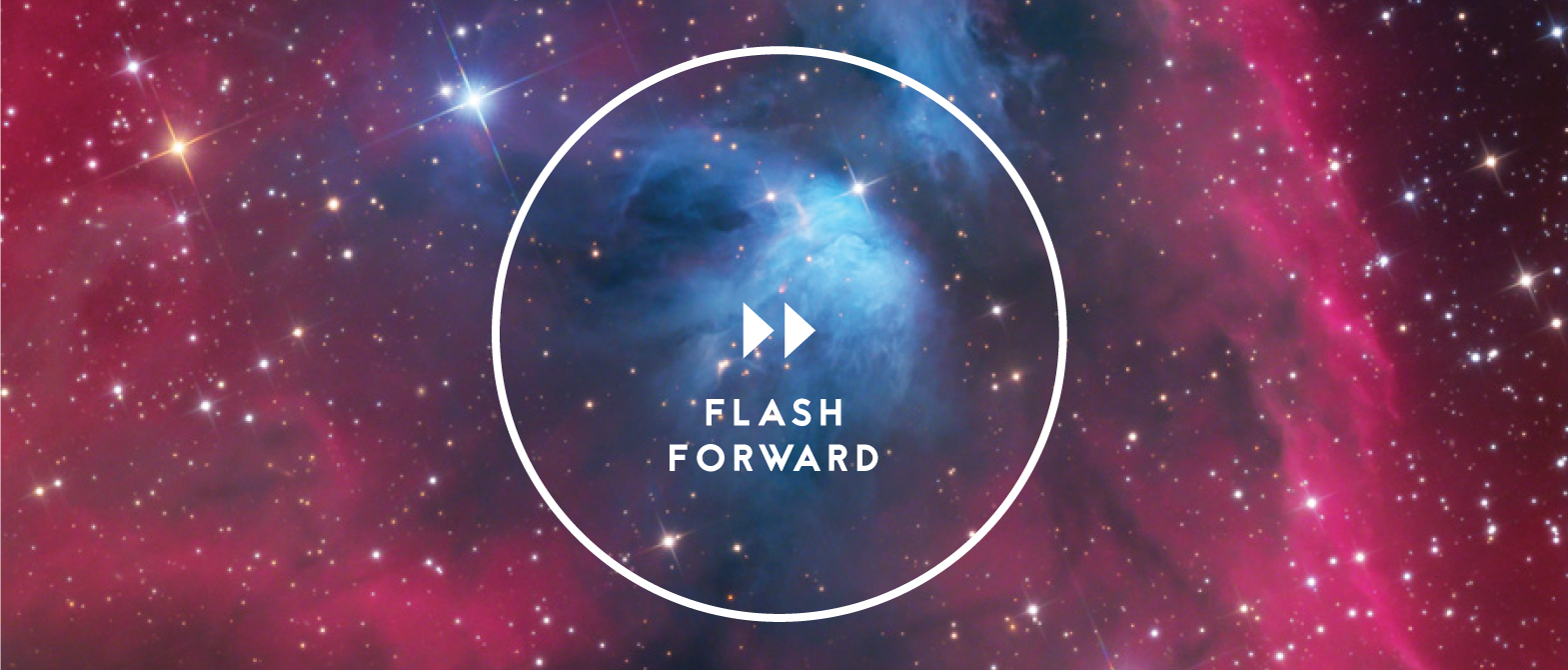
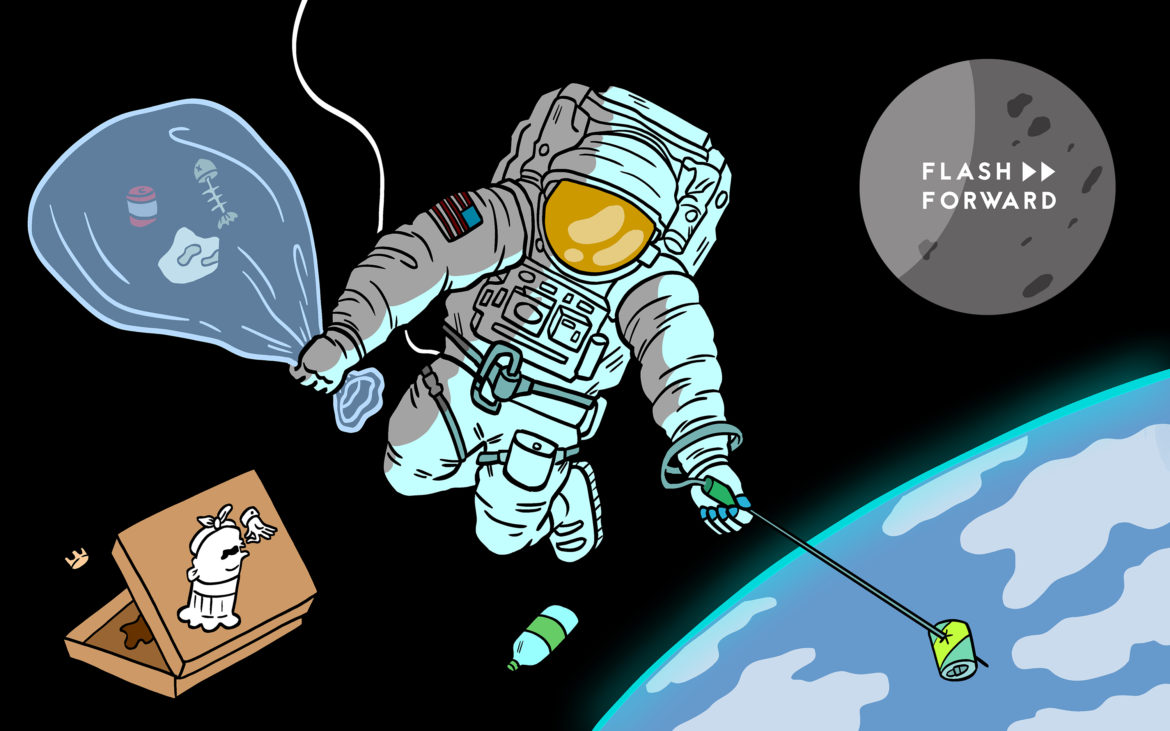



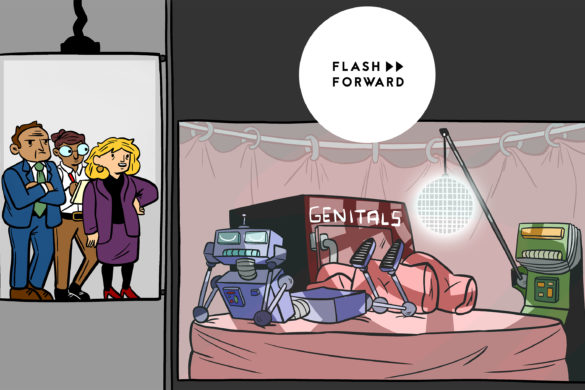

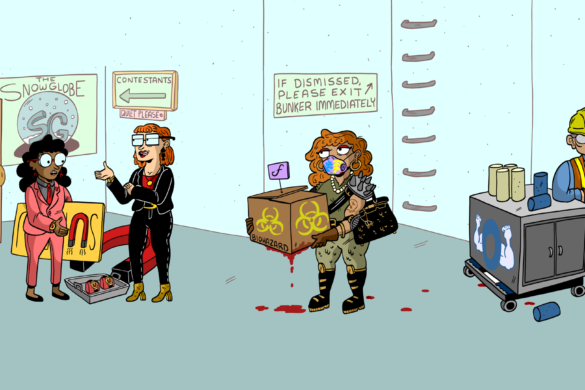
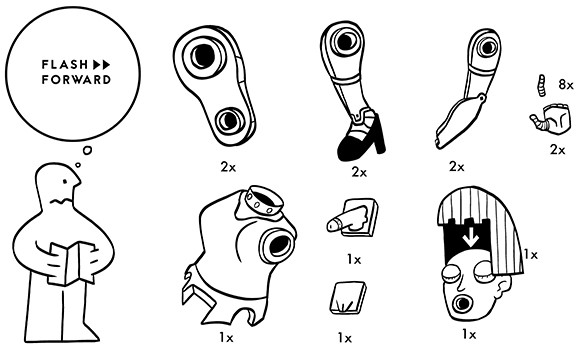

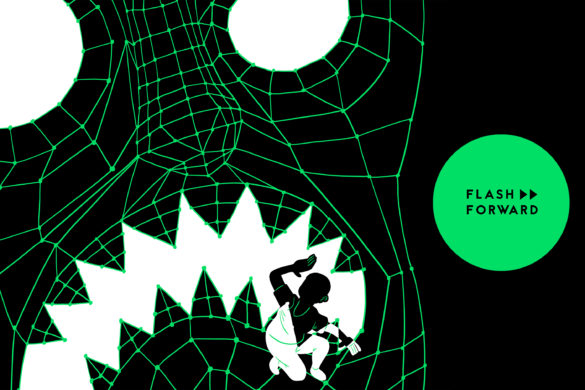
3 comments
GREAT VIDEO. OK, I WANT MY NOBEL FOR GIVING THIS AWAY. BUILD THE SATELLITES SO THAT AT THEIR END OF LIFETIME, THE SATELLITE ENWRAPS ITSELF INSIDE A PROTECTIVE SHELL LIKE A REVERSE AIRBAG.
THIS COULD BE ACHIEVED MANY WAYS. THE AIRBAG COULD BE MADE OF TEFLON. OR THE AIRBAG CAN BE A LIQUID METAL LIKE SODER WHICH DRIES THE ENTIRE OBJECT INTO ONE LARGE PROTECTED DEVICE THAT BURNS ON RER-ENTRY INTO THE ATMOSPHERE.
IT HAS TO BE AN INDUSTRY-WIDE APPROACH AGREED ON ALL BY INTERNATIONAL SPACE ACTORS. THERE’S NO WAY ONE COMPANY IS GOING CLEAN UP AFTER GOVERNMENTS. ONE COMPANY COULD OF COURSE, GET PAID FOR PRETENDING TO DO THE WORK. BUT REALISTICALLY THERE IS JUST NO WAY ONE COMPANY WILL DO IT.
[…] had come across Dr Alice Gorman in the Flash Forward episode on space junk. So when the episode downloaded and I saw the title and the show notes, it was a pleasant surprise […]
[…] they didn’t collide, but the near miss was a reminder of just how much junk is up there (which we’ve talked about on Flash Forward before). And here’s another thing to worry about: even if the stuff up there doesn’t collide, […]